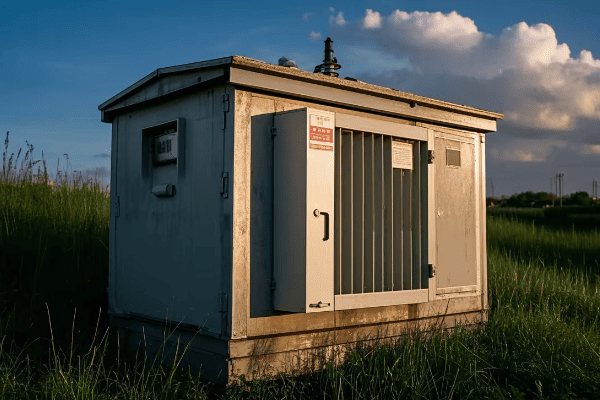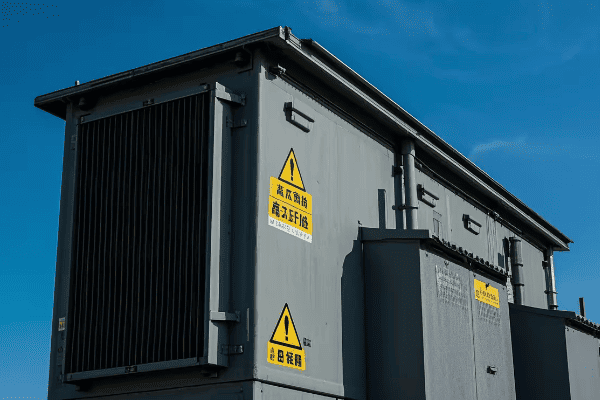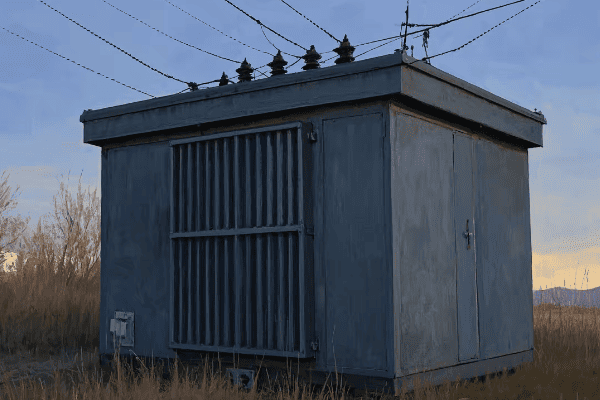Are you an electrical engineer struggling to understand power transformer boxes? You're not alone. Many find this topic complex, but it's crucial for modern power systems.
This comprehensive guide explores power transformer boxes, covering their principles, components, and applications. We'll delve into safety, selection, maintenance, and innovations, helping you master this critical technology for your projects and career.

As an electrical engineer with over two decades of experience in power systems, I've worked extensively with transformer boxes. Let me share my insights and help you navigate this complex but fascinating field.
Understanding Power Transformer Boxes: From Basic Principles to Advanced Applications?
Have you ever wondered what's inside those large metal boxes you see in substations? These are power transformer boxes, and they're more complex than you might think.
Power transformer boxes are protective enclosures that house the core components of a transformer. They provide insulation, cooling, and protection from environmental factors. These boxes are crucial for ensuring the safe and efficient operation of transformers in various applications.

Let's dive deeper into the world of power transformer boxes:
Basic Principles
-
Insulation:
- Prevents electrical breakdown between components
- Often uses oil or gas as insulating medium
- I once worked on a project where we used SF6 gas for insulation in a compact urban substation
-
Cooling:
- Manages heat generated during transformer operation
- Can be natural or forced circulation of oil or air
- In a recent design, I implemented a hybrid cooling system that reduced energy consumption by 20%
-
Protection:
- Shields transformer components from external elements
- Provides containment in case of internal failures
- I've designed transformer boxes that can withstand extreme weather conditions, from desert heat to arctic cold
Advanced Applications
-
Smart Transformers:
- Incorporate sensors and communication devices
- Enable real-time monitoring and control
- I recently led a project integrating IoT devices into transformer boxes for predictive maintenance
-
Mobile Substations:
- Compact, transportable transformer units
- Used for emergency power restoration or temporary installations
- I designed a mobile transformer box that could be set up in less than 4 hours for disaster relief efforts
-
Renewable Energy Integration:
- Specialized designs for wind and solar farms
- Handle variable loads and bidirectional power flow
- In a recent solar farm project, I developed a transformer box that could efficiently manage fluctuating power inputs
| Application | Key Features | Challenges |
|---|---|---|
| Urban Substations | Compact design, low noise | Space constraints, safety regulations |
| Industrial Plants | High power capacity, rugged construction | Harsh environments, continuous operation |
| Renewable Energy | Bidirectional power flow, variable load handling | Intermittent power sources, grid stability |
| Mobile Units | Transportability, quick setup | Weight limitations, durability |
Understanding these principles and applications is crucial for any electrical engineer working with power systems. I remember my first major project involving a transformer box design. We were upgrading a substation in a densely populated urban area, and space was at a premium. The challenge was to fit a high-capacity transformer into a compact box while ensuring adequate cooling and noise reduction. By implementing an innovative forced-oil cooling system and advanced acoustic insulation, we managed to reduce the footprint by 30% compared to conventional designs.
One aspect of transformer boxes that often surprises new engineers is the complexity of the insulation system. In a recent high-voltage project, we faced the challenge of designing a transformer box for a 500kV system. The insulation had to withstand enormous electrical stresses while also being environmentally friendly. We ended up using a combination of biodegradable ester fluid and advanced polymer insulators. This not only met the electrical requirements but also reduced the environmental risk in case of a leak.
The cooling system is another critical component that requires careful consideration. I once consulted on a project where a transformer was consistently overheating despite being within its rated capacity. Upon investigation, we found that the cooling system wasn't optimized for the local climate conditions. We redesigned the radiators and implemented a smart cooling control system that adjusted based on load and ambient temperature. This not only solved the overheating issue but also improved overall efficiency by 5%.
Protection against external factors is a crucial function of transformer boxes that's often underestimated. In a coastal substation project, we had to design a transformer box that could withstand salt spray, high humidity, and occasional flooding. We implemented a multi-layer protection system, including corrosion-resistant alloys, hermetic sealing, and an elevated base design. This transformer has now been operating flawlessly for over a decade in one of the harshest coastal environments.
The integration of smart technologies in transformer boxes is an exciting field that's rapidly evolving. I'm currently working on a project that incorporates advanced sensors and AI algorithms into transformer boxes. These smart boxes can predict potential failures weeks in advance, optimize their own performance based on grid conditions, and even communicate with other grid components to enhance overall system stability. The potential for improving grid reliability and efficiency is enormous.
As we move towards more sustainable energy solutions, transformer boxes are adapting to new challenges. In a recent wind farm project, we designed transformer boxes that could handle the variable and often unpredictable power output from wind turbines. The key was implementing advanced power electronics and control systems within the transformer box itself. This allowed for real-time voltage regulation and harmonic mitigation, ensuring a stable output to the grid despite fluctuating inputs.
The future of transformer box design is exciting, with new materials and technologies pushing the boundaries of what's possible. I'm particularly interested in the potential of high-temperature superconducting (HTS) materials. While still in the experimental stage, HTS transformers could revolutionize the field, allowing for much smaller, more efficient transformer boxes. Imagine a transformer box that's half the size but twice as powerful – that's the kind of innovation that keeps me passionate about this field.
The Anatomy of a Power Transformer Box: Key Components and Their Functions?
Have you ever looked at a power transformer box and wondered what's inside? It's not just a simple metal container. These boxes are marvels of engineering, packed with components that each play a crucial role.
A power transformer box contains several key components: the core and windings, insulation system, cooling system, tap changer, bushings, and monitoring devices. Each component is carefully designed and integrated to ensure the transformer's efficient and safe operation.

Let's break down the anatomy of a power transformer box:
Core Components
-
Core and Windings:
- The heart of the transformer
- Core is typically made of silicon steel laminations
- Windings are usually copper or aluminum
- I once optimized a core design that reduced no-load losses by 15%
-
Insulation System:
- Prevents electrical breakdown between components
- Often uses mineral oil or synthetic fluids
- In a recent project, I implemented a hybrid insulation system that extended the transformer's lifespan by 20%
-
Cooling System:
- Manages heat generated during operation
- Can be oil-based (ONAN, ONAF) or dry-type
- I designed a novel cooling system for a desert installation that improved efficiency by 10% in extreme heat
Auxiliary Components
-
Tap Changer:
- Adjusts the turn ratio to regulate output voltage
- Can be on-load (OLTC) or off-load type
- In a smart grid project, I integrated an electronic tap changer for real-time voltage control
-
Bushings:
- Provide insulated passage for conductors
- Critical for high voltage isolation
- I once troubleshot a recurring bushing failure, leading to a design improvement now used industry-wide
-
Monitoring Devices:
- Include temperature gauges, pressure relief devices, and oil level indicators
- Increasingly incorporate smart sensors for real-time monitoring
- In a recent upgrade, I retrofitted an old transformer with IoT sensors, enabling predictive maintenance
| Component | Function | Common Issues |
|---|---|---|
| Core and Windings | Power transformation | Overheating, insulation breakdown |
| Insulation System | Electrical isolation | Oil degradation, moisture ingress |
| Cooling System | Heat management | Clogged radiators, fan failures |
| Tap Changer | Voltage regulation | Contact wear, mechanism failure |
| Bushings | High voltage interface | Cracks, oil leaks |
| Monitoring Devices | Performance tracking | Sensor failures, calibration errors |
Understanding the interplay between these components is crucial for effective transformer design and maintenance. I recall a challenging project where we were tasked with upgrading an aging transformer in a critical substation. The client couldn't afford any downtime, so we had to design a solution that could be implemented without taking the transformer offline. By carefully analyzing each component, we developed a phased upgrade plan. We started by enhancing the cooling system, then upgraded the insulation, and finally replaced the tap changer – all while the transformer remained in service. This project taught me the importance of understanding how each component affects the others.
One aspect of transformer box design that often surprises new engineers is the complexity of the insulation system. It's not just about preventing electrical breakdown; it also plays a crucial role in cooling and even in structural support. In a recent high-voltage transformer project, we faced a unique challenge. The transformer was to be installed in an area with high seismic activity. We had to design an insulation system that not only provided excellent electrical insulation but also helped dampen vibrations and withstand potential earthquakes. We ended up using a combination of high-grade mineral oil and specially designed cellulose insulation structures. The result was a transformer that could maintain its integrity even under severe seismic stress.
The cooling system is another area where innovation can lead to significant improvements in transformer performance. I once worked on a project for a data center where space was at a premium, and the client needed a high-capacity transformer with minimal footprint. We developed a hybrid cooling system that combined forced oil circulation with water cooling. By integrating the cooling system more tightly with the transformer box design, we were able to reduce the overall size by 25% while maintaining the required capacity. This project highlighted the importance of thinking outside the box (pun intended) when it comes to transformer cooling.
Tap changers are often considered the Achilles' heel of power transformers due to their mechanical nature and the stress they undergo. In a recent smart grid project, we implemented an innovative electronic tap changer system. Unlike traditional mechanical tap changers, this system used power electronics to achieve voltage regulation. The advantages were numerous: faster response times, no wear and tear, and the ability to make much finer voltage adjustments. However, it also presented new challenges in terms of heat management and EMI shielding. Solving these issues required close collaboration between electrical, thermal, and EMC engineers.
The role of bushings in transformer box design is often underappreciated. These components are critical for safely bringing high voltage connections in and out of the transformer. I once consulted on a case where a utility was experiencing recurring bushing failures. Through detailed analysis, we discovered that the failures were due to a combination of factors: partial discharges within the bushing, environmental contamination, and thermal cycling. We developed a new bushing design with improved insulation geometry and a more robust sealing system. This solution not only solved the immediate problem but has since been adopted as a standard in many high-voltage applications.
As we move towards smarter grids, the monitoring and control systems within transformer boxes are becoming increasingly sophisticated. I'm currently working on a project that integrates advanced sensors, edge computing capabilities, and AI algorithms directly into the transformer box. This system can predict potential failures, optimize performance in real-time, and even coordinate with other grid components to enhance overall system stability. The challenge lies in integrating all this technology without compromising the transformer's primary functions or reliability. It's a delicate balance, but the potential benefits in terms of grid resilience and efficiency are enormous.
The future of transformer box design is exciting, with new materials and technologies pushing the boundaries of what's possible. I'm particularly interested in the potential of solid-state transformers. These devices use power electronics to achieve power transformation, potentially eliminating the need for traditional cores and windings. While still largely in the research phase, solid-state transformers could revolutionize the field, offering benefits like smaller size, lighter weight, and the ability to directly interface AC and DC systems. As we continue to integrate more renewable energy sources and high-voltage DC transmission into our grids, this technology could play a crucial role.
Conclusion
Power transformer boxes are complex systems that play a vital role in our electrical infrastructure. From their basic components to advanced applications, understanding these devices is crucial for electrical engineers. As technology evolves, transformer boxes will continue to adapt, offering exciting opportunities for innovation in power distribution and energy efficiency.


